Project on Effect of Job Satisfaction and Motivation on Performance
VerifiedAdded on 2020/03/04
|37
|6597
|194
Project
AI Summary
This project investigates the relationship between job satisfaction, motivation, and employee performance, focusing on the context of companies in Switzerland. The project begins with an introduction, outlining the background, problem statement, objectives, significance, scope, and limitations of the study. Chapter Two provides a comprehensive literature review, examining relevant theories such as Hertzberg’s Two-Factor Theory and Locke’s Value Theory, as well as secondary research on factors like gender, position, training, and leadership styles. The methodology, detailed in Chapter Three, covers research design, target population, sampling design, data collection procedures, and ethical considerations. Chapter Four presents the data analysis, while Chapter Five discusses the findings and offers recommendations. Chapter Six concludes the project. The research aims to determine how job satisfaction and motivation influence employee performance and contribute to policy formulation and future research in the field. The project also addresses the challenges of employee retention and the importance of employee satisfaction in fostering innovation and productivity.
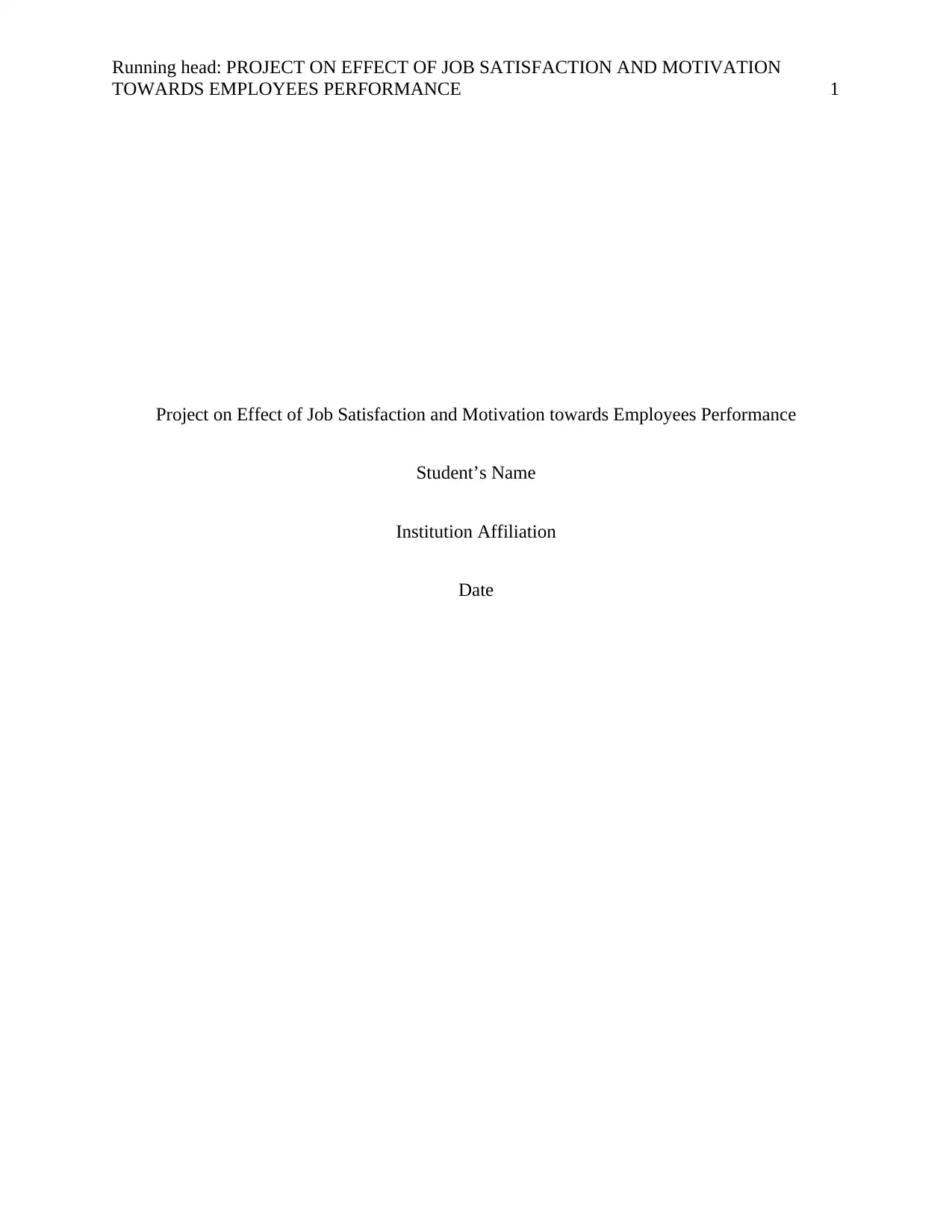
Running head: PROJECT ON EFFECT OF JOB SATISFACTION AND MOTIVATION
TOWARDS EMPLOYEES PERFORMANCE 1
Project on Effect of Job Satisfaction and Motivation towards Employees Performance
Student’s Name
Institution Affiliation
Date
TOWARDS EMPLOYEES PERFORMANCE 1
Project on Effect of Job Satisfaction and Motivation towards Employees Performance
Student’s Name
Institution Affiliation
Date
Paraphrase This Document
Need a fresh take? Get an instant paraphrase of this document with our AI Paraphraser
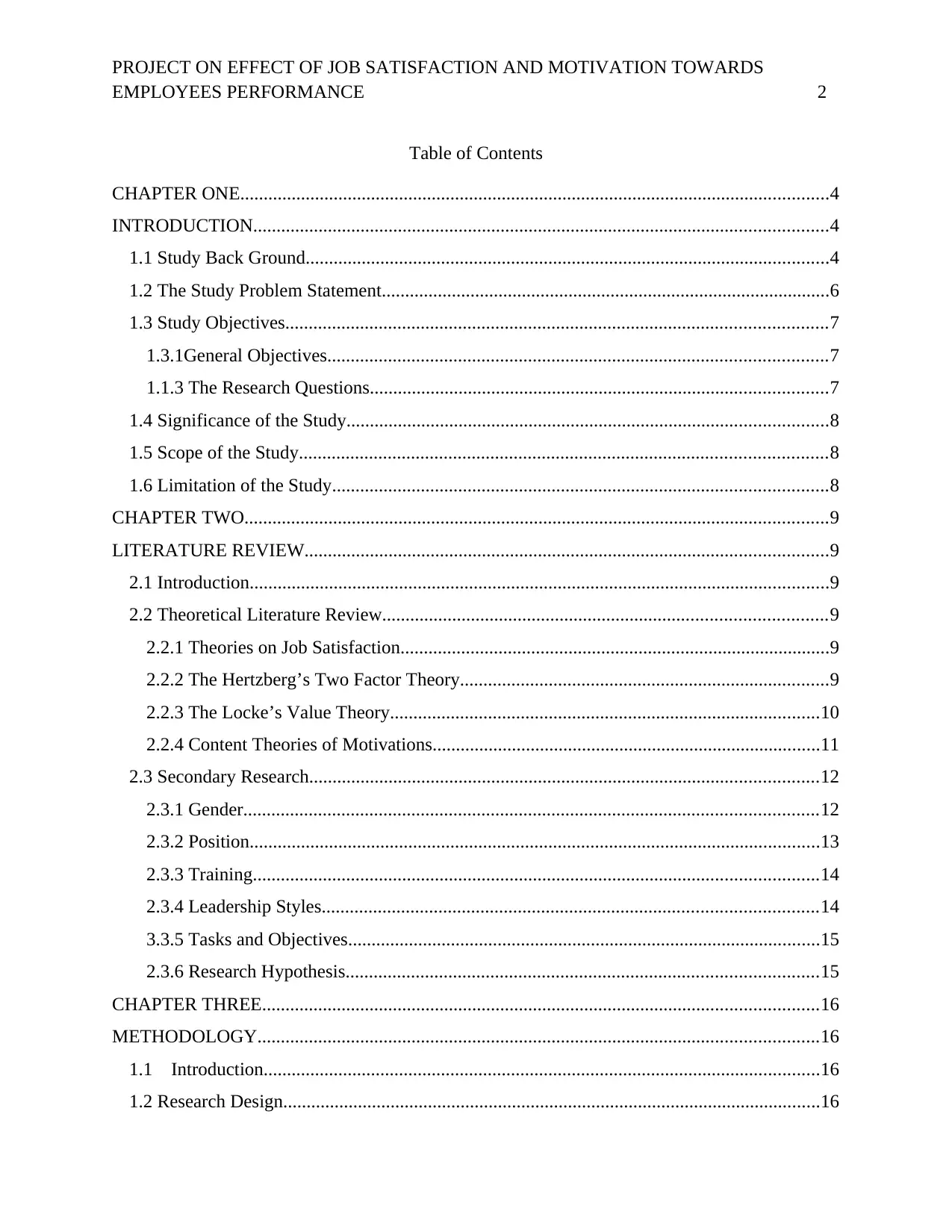
PROJECT ON EFFECT OF JOB SATISFACTION AND MOTIVATION TOWARDS
EMPLOYEES PERFORMANCE 2
Table of Contents
CHAPTER ONE..............................................................................................................................4
INTRODUCTION...........................................................................................................................4
1.1 Study Back Ground................................................................................................................4
1.2 The Study Problem Statement................................................................................................6
1.3 Study Objectives....................................................................................................................7
1.3.1General Objectives...........................................................................................................7
1.1.3 The Research Questions..................................................................................................7
1.4 Significance of the Study.......................................................................................................8
1.5 Scope of the Study.................................................................................................................8
1.6 Limitation of the Study..........................................................................................................8
CHAPTER TWO.............................................................................................................................9
LITERATURE REVIEW................................................................................................................9
2.1 Introduction............................................................................................................................9
2.2 Theoretical Literature Review...............................................................................................9
2.2.1 Theories on Job Satisfaction............................................................................................9
2.2.2 The Hertzberg’s Two Factor Theory...............................................................................9
2.2.3 The Locke’s Value Theory............................................................................................10
2.2.4 Content Theories of Motivations...................................................................................11
2.3 Secondary Research.............................................................................................................12
2.3.1 Gender...........................................................................................................................12
2.3.2 Position..........................................................................................................................13
2.3.3 Training.........................................................................................................................14
2.3.4 Leadership Styles..........................................................................................................14
3.3.5 Tasks and Objectives.....................................................................................................15
2.3.6 Research Hypothesis.....................................................................................................15
CHAPTER THREE.......................................................................................................................16
METHODOLOGY........................................................................................................................16
1.1 Introduction.......................................................................................................................16
1.2 Research Design...................................................................................................................16
EMPLOYEES PERFORMANCE 2
Table of Contents
CHAPTER ONE..............................................................................................................................4
INTRODUCTION...........................................................................................................................4
1.1 Study Back Ground................................................................................................................4
1.2 The Study Problem Statement................................................................................................6
1.3 Study Objectives....................................................................................................................7
1.3.1General Objectives...........................................................................................................7
1.1.3 The Research Questions..................................................................................................7
1.4 Significance of the Study.......................................................................................................8
1.5 Scope of the Study.................................................................................................................8
1.6 Limitation of the Study..........................................................................................................8
CHAPTER TWO.............................................................................................................................9
LITERATURE REVIEW................................................................................................................9
2.1 Introduction............................................................................................................................9
2.2 Theoretical Literature Review...............................................................................................9
2.2.1 Theories on Job Satisfaction............................................................................................9
2.2.2 The Hertzberg’s Two Factor Theory...............................................................................9
2.2.3 The Locke’s Value Theory............................................................................................10
2.2.4 Content Theories of Motivations...................................................................................11
2.3 Secondary Research.............................................................................................................12
2.3.1 Gender...........................................................................................................................12
2.3.2 Position..........................................................................................................................13
2.3.3 Training.........................................................................................................................14
2.3.4 Leadership Styles..........................................................................................................14
3.3.5 Tasks and Objectives.....................................................................................................15
2.3.6 Research Hypothesis.....................................................................................................15
CHAPTER THREE.......................................................................................................................16
METHODOLOGY........................................................................................................................16
1.1 Introduction.......................................................................................................................16
1.2 Research Design...................................................................................................................16
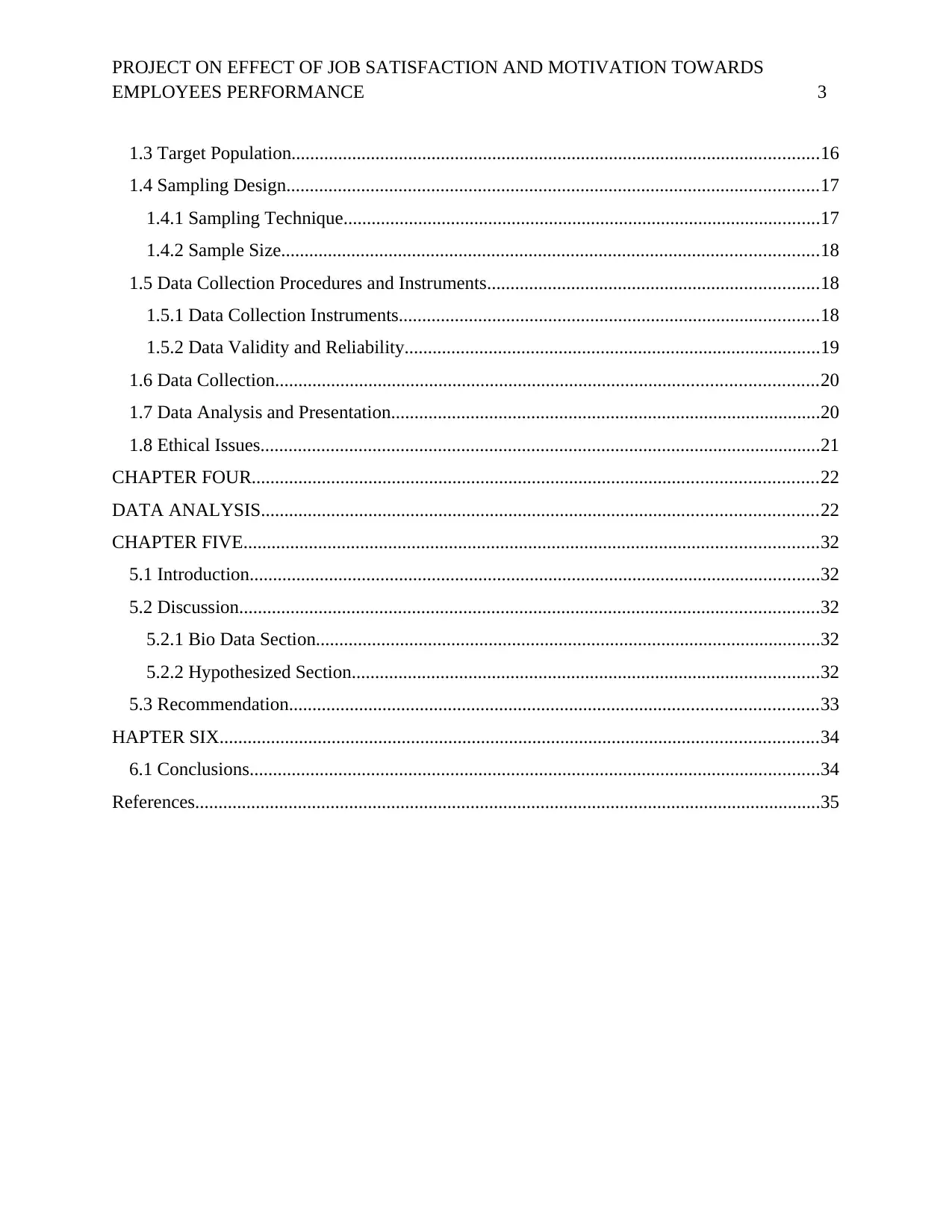
PROJECT ON EFFECT OF JOB SATISFACTION AND MOTIVATION TOWARDS
EMPLOYEES PERFORMANCE 3
1.3 Target Population.................................................................................................................16
1.4 Sampling Design..................................................................................................................17
1.4.1 Sampling Technique......................................................................................................17
1.4.2 Sample Size...................................................................................................................18
1.5 Data Collection Procedures and Instruments.......................................................................18
1.5.1 Data Collection Instruments..........................................................................................18
1.5.2 Data Validity and Reliability.........................................................................................19
1.6 Data Collection....................................................................................................................20
1.7 Data Analysis and Presentation............................................................................................20
1.8 Ethical Issues........................................................................................................................21
CHAPTER FOUR.........................................................................................................................22
DATA ANALYSIS.......................................................................................................................22
CHAPTER FIVE...........................................................................................................................32
5.1 Introduction..........................................................................................................................32
5.2 Discussion............................................................................................................................32
5.2.1 Bio Data Section............................................................................................................32
5.2.2 Hypothesized Section....................................................................................................32
5.3 Recommendation.................................................................................................................33
HAPTER SIX................................................................................................................................34
6.1 Conclusions..........................................................................................................................34
References......................................................................................................................................35
EMPLOYEES PERFORMANCE 3
1.3 Target Population.................................................................................................................16
1.4 Sampling Design..................................................................................................................17
1.4.1 Sampling Technique......................................................................................................17
1.4.2 Sample Size...................................................................................................................18
1.5 Data Collection Procedures and Instruments.......................................................................18
1.5.1 Data Collection Instruments..........................................................................................18
1.5.2 Data Validity and Reliability.........................................................................................19
1.6 Data Collection....................................................................................................................20
1.7 Data Analysis and Presentation............................................................................................20
1.8 Ethical Issues........................................................................................................................21
CHAPTER FOUR.........................................................................................................................22
DATA ANALYSIS.......................................................................................................................22
CHAPTER FIVE...........................................................................................................................32
5.1 Introduction..........................................................................................................................32
5.2 Discussion............................................................................................................................32
5.2.1 Bio Data Section............................................................................................................32
5.2.2 Hypothesized Section....................................................................................................32
5.3 Recommendation.................................................................................................................33
HAPTER SIX................................................................................................................................34
6.1 Conclusions..........................................................................................................................34
References......................................................................................................................................35
⊘ This is a preview!⊘
Do you want full access?
Subscribe today to unlock all pages.

Trusted by 1+ million students worldwide
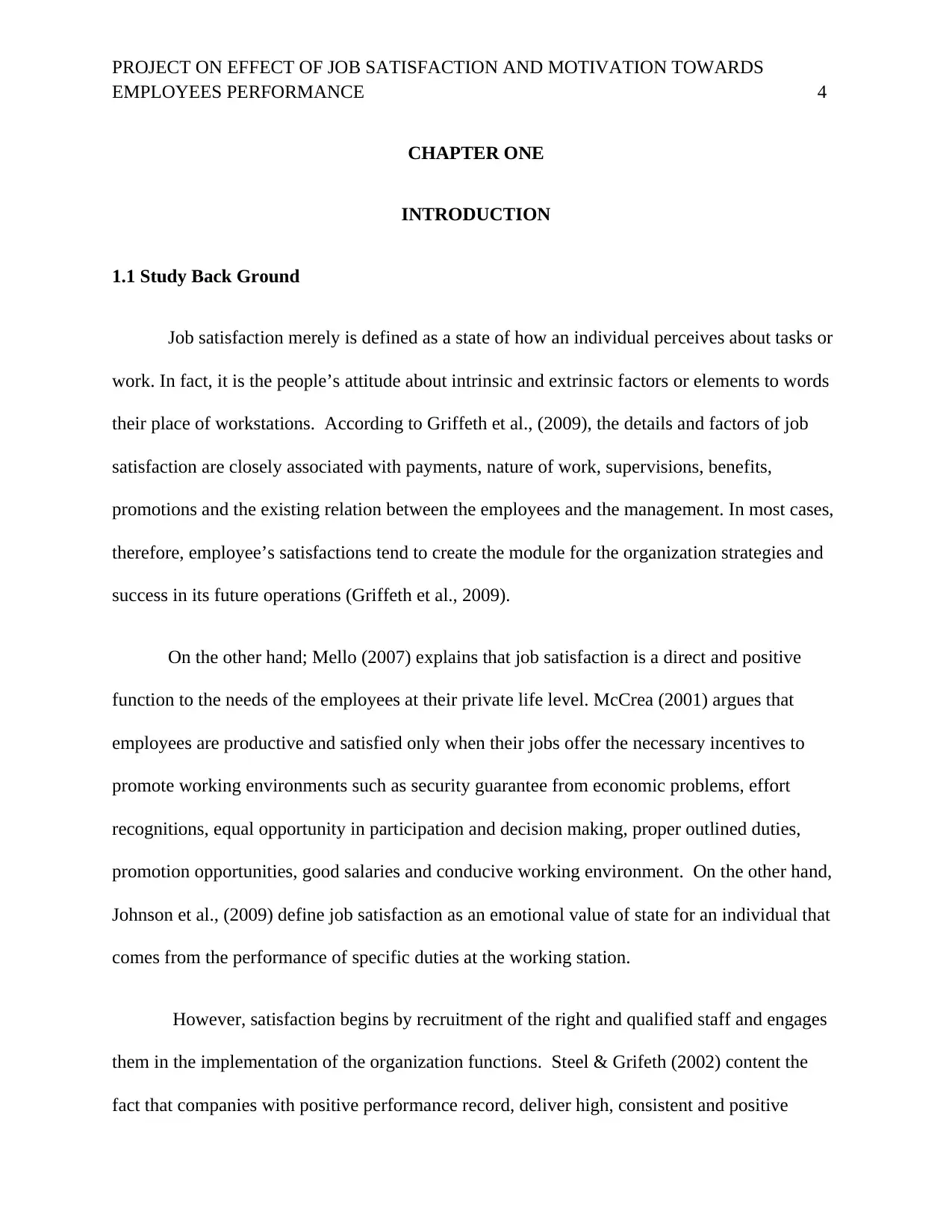
PROJECT ON EFFECT OF JOB SATISFACTION AND MOTIVATION TOWARDS
EMPLOYEES PERFORMANCE 4
CHAPTER ONE
INTRODUCTION
1.1 Study Back Ground
Job satisfaction merely is defined as a state of how an individual perceives about tasks or
work. In fact, it is the people’s attitude about intrinsic and extrinsic factors or elements to words
their place of workstations. According to Griffeth et al., (2009), the details and factors of job
satisfaction are closely associated with payments, nature of work, supervisions, benefits,
promotions and the existing relation between the employees and the management. In most cases,
therefore, employee’s satisfactions tend to create the module for the organization strategies and
success in its future operations (Griffeth et al., 2009).
On the other hand; Mello (2007) explains that job satisfaction is a direct and positive
function to the needs of the employees at their private life level. McCrea (2001) argues that
employees are productive and satisfied only when their jobs offer the necessary incentives to
promote working environments such as security guarantee from economic problems, effort
recognitions, equal opportunity in participation and decision making, proper outlined duties,
promotion opportunities, good salaries and conducive working environment. On the other hand,
Johnson et al., (2009) define job satisfaction as an emotional value of state for an individual that
comes from the performance of specific duties at the working station.
However, satisfaction begins by recruitment of the right and qualified staff and engages
them in the implementation of the organization functions. Steel & Grifeth (2002) content the
fact that companies with positive performance record, deliver high, consistent and positive
EMPLOYEES PERFORMANCE 4
CHAPTER ONE
INTRODUCTION
1.1 Study Back Ground
Job satisfaction merely is defined as a state of how an individual perceives about tasks or
work. In fact, it is the people’s attitude about intrinsic and extrinsic factors or elements to words
their place of workstations. According to Griffeth et al., (2009), the details and factors of job
satisfaction are closely associated with payments, nature of work, supervisions, benefits,
promotions and the existing relation between the employees and the management. In most cases,
therefore, employee’s satisfactions tend to create the module for the organization strategies and
success in its future operations (Griffeth et al., 2009).
On the other hand; Mello (2007) explains that job satisfaction is a direct and positive
function to the needs of the employees at their private life level. McCrea (2001) argues that
employees are productive and satisfied only when their jobs offer the necessary incentives to
promote working environments such as security guarantee from economic problems, effort
recognitions, equal opportunity in participation and decision making, proper outlined duties,
promotion opportunities, good salaries and conducive working environment. On the other hand,
Johnson et al., (2009) define job satisfaction as an emotional value of state for an individual that
comes from the performance of specific duties at the working station.
However, satisfaction begins by recruitment of the right and qualified staff and engages
them in the implementation of the organization functions. Steel & Grifeth (2002) content the
fact that companies with positive performance record, deliver high, consistent and positive
Paraphrase This Document
Need a fresh take? Get an instant paraphrase of this document with our AI Paraphraser
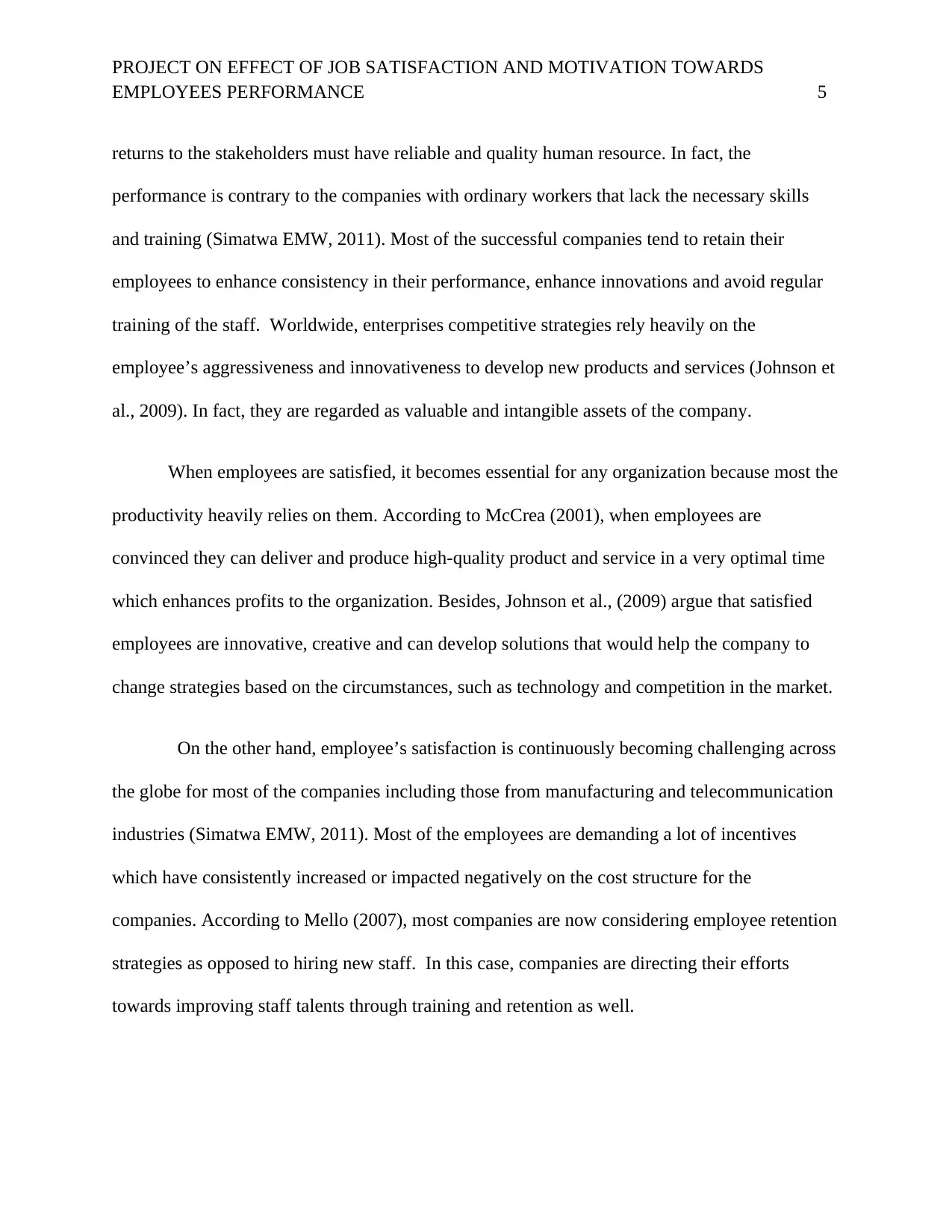
PROJECT ON EFFECT OF JOB SATISFACTION AND MOTIVATION TOWARDS
EMPLOYEES PERFORMANCE 5
returns to the stakeholders must have reliable and quality human resource. In fact, the
performance is contrary to the companies with ordinary workers that lack the necessary skills
and training (Simatwa EMW, 2011). Most of the successful companies tend to retain their
employees to enhance consistency in their performance, enhance innovations and avoid regular
training of the staff. Worldwide, enterprises competitive strategies rely heavily on the
employee’s aggressiveness and innovativeness to develop new products and services (Johnson et
al., 2009). In fact, they are regarded as valuable and intangible assets of the company.
When employees are satisfied, it becomes essential for any organization because most the
productivity heavily relies on them. According to McCrea (2001), when employees are
convinced they can deliver and produce high-quality product and service in a very optimal time
which enhances profits to the organization. Besides, Johnson et al., (2009) argue that satisfied
employees are innovative, creative and can develop solutions that would help the company to
change strategies based on the circumstances, such as technology and competition in the market.
On the other hand, employee’s satisfaction is continuously becoming challenging across
the globe for most of the companies including those from manufacturing and telecommunication
industries (Simatwa EMW, 2011). Most of the employees are demanding a lot of incentives
which have consistently increased or impacted negatively on the cost structure for the
companies. According to Mello (2007), most companies are now considering employee retention
strategies as opposed to hiring new staff. In this case, companies are directing their efforts
towards improving staff talents through training and retention as well.
EMPLOYEES PERFORMANCE 5
returns to the stakeholders must have reliable and quality human resource. In fact, the
performance is contrary to the companies with ordinary workers that lack the necessary skills
and training (Simatwa EMW, 2011). Most of the successful companies tend to retain their
employees to enhance consistency in their performance, enhance innovations and avoid regular
training of the staff. Worldwide, enterprises competitive strategies rely heavily on the
employee’s aggressiveness and innovativeness to develop new products and services (Johnson et
al., 2009). In fact, they are regarded as valuable and intangible assets of the company.
When employees are satisfied, it becomes essential for any organization because most the
productivity heavily relies on them. According to McCrea (2001), when employees are
convinced they can deliver and produce high-quality product and service in a very optimal time
which enhances profits to the organization. Besides, Johnson et al., (2009) argue that satisfied
employees are innovative, creative and can develop solutions that would help the company to
change strategies based on the circumstances, such as technology and competition in the market.
On the other hand, employee’s satisfaction is continuously becoming challenging across
the globe for most of the companies including those from manufacturing and telecommunication
industries (Simatwa EMW, 2011). Most of the employees are demanding a lot of incentives
which have consistently increased or impacted negatively on the cost structure for the
companies. According to Mello (2007), most companies are now considering employee retention
strategies as opposed to hiring new staff. In this case, companies are directing their efforts
towards improving staff talents through training and retention as well.
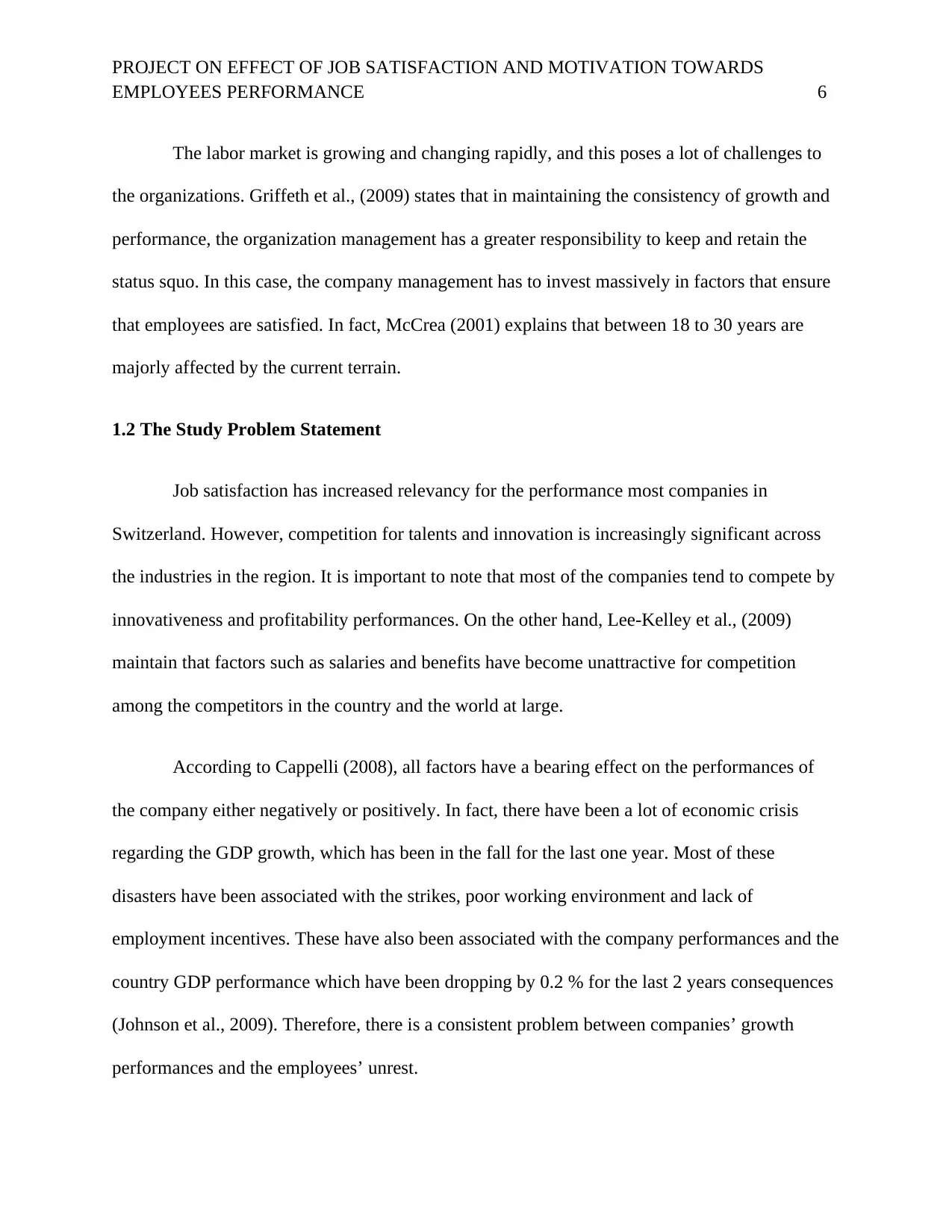
PROJECT ON EFFECT OF JOB SATISFACTION AND MOTIVATION TOWARDS
EMPLOYEES PERFORMANCE 6
The labor market is growing and changing rapidly, and this poses a lot of challenges to
the organizations. Griffeth et al., (2009) states that in maintaining the consistency of growth and
performance, the organization management has a greater responsibility to keep and retain the
status squo. In this case, the company management has to invest massively in factors that ensure
that employees are satisfied. In fact, McCrea (2001) explains that between 18 to 30 years are
majorly affected by the current terrain.
1.2 The Study Problem Statement
Job satisfaction has increased relevancy for the performance most companies in
Switzerland. However, competition for talents and innovation is increasingly significant across
the industries in the region. It is important to note that most of the companies tend to compete by
innovativeness and profitability performances. On the other hand, Lee-Kelley et al., (2009)
maintain that factors such as salaries and benefits have become unattractive for competition
among the competitors in the country and the world at large.
According to Cappelli (2008), all factors have a bearing effect on the performances of
the company either negatively or positively. In fact, there have been a lot of economic crisis
regarding the GDP growth, which has been in the fall for the last one year. Most of these
disasters have been associated with the strikes, poor working environment and lack of
employment incentives. These have also been associated with the company performances and the
country GDP performance which have been dropping by 0.2 % for the last 2 years consequences
(Johnson et al., 2009). Therefore, there is a consistent problem between companies’ growth
performances and the employees’ unrest.
EMPLOYEES PERFORMANCE 6
The labor market is growing and changing rapidly, and this poses a lot of challenges to
the organizations. Griffeth et al., (2009) states that in maintaining the consistency of growth and
performance, the organization management has a greater responsibility to keep and retain the
status squo. In this case, the company management has to invest massively in factors that ensure
that employees are satisfied. In fact, McCrea (2001) explains that between 18 to 30 years are
majorly affected by the current terrain.
1.2 The Study Problem Statement
Job satisfaction has increased relevancy for the performance most companies in
Switzerland. However, competition for talents and innovation is increasingly significant across
the industries in the region. It is important to note that most of the companies tend to compete by
innovativeness and profitability performances. On the other hand, Lee-Kelley et al., (2009)
maintain that factors such as salaries and benefits have become unattractive for competition
among the competitors in the country and the world at large.
According to Cappelli (2008), all factors have a bearing effect on the performances of
the company either negatively or positively. In fact, there have been a lot of economic crisis
regarding the GDP growth, which has been in the fall for the last one year. Most of these
disasters have been associated with the strikes, poor working environment and lack of
employment incentives. These have also been associated with the company performances and the
country GDP performance which have been dropping by 0.2 % for the last 2 years consequences
(Johnson et al., 2009). Therefore, there is a consistent problem between companies’ growth
performances and the employees’ unrest.
⊘ This is a preview!⊘
Do you want full access?
Subscribe today to unlock all pages.

Trusted by 1+ million students worldwide
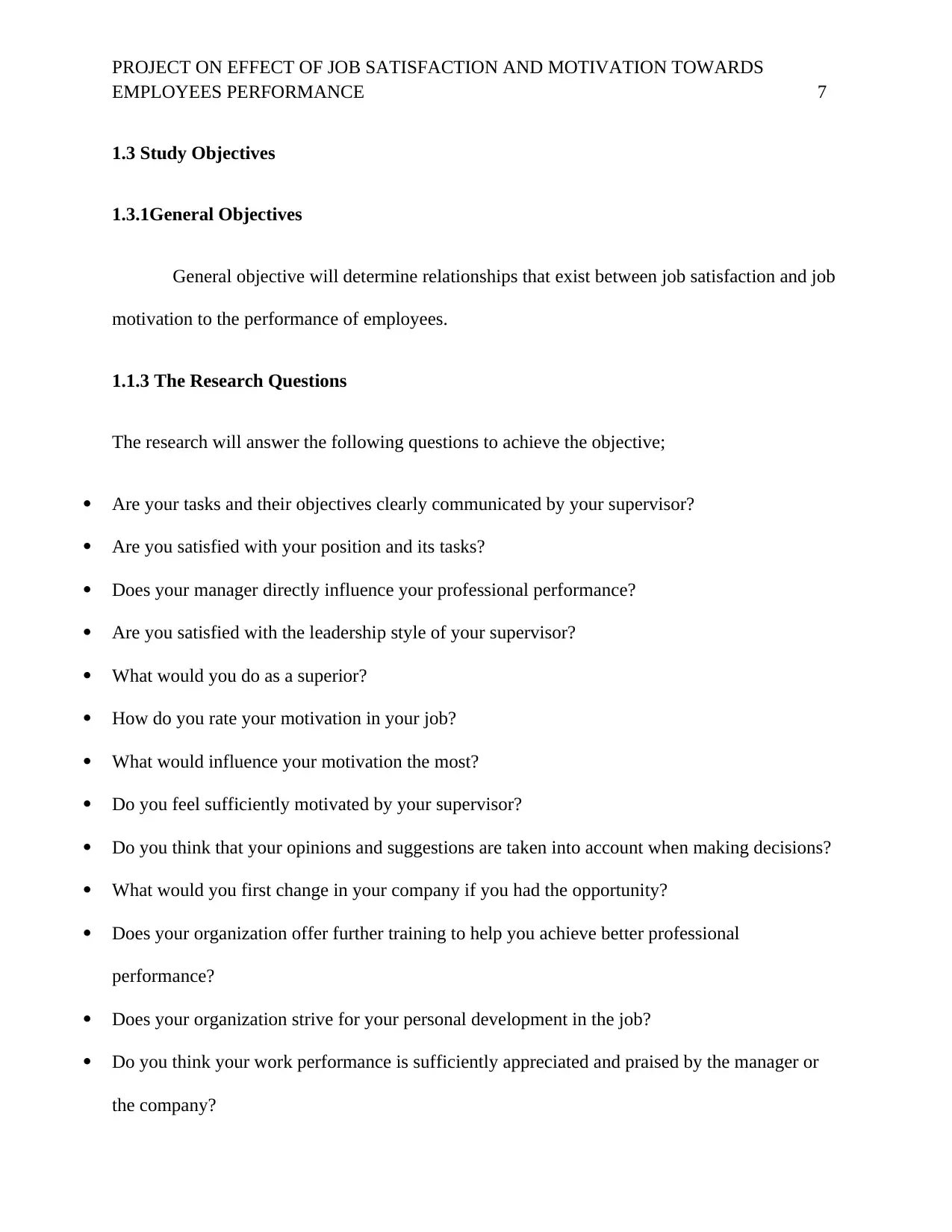
PROJECT ON EFFECT OF JOB SATISFACTION AND MOTIVATION TOWARDS
EMPLOYEES PERFORMANCE 7
1.3 Study Objectives
1.3.1General Objectives
General objective will determine relationships that exist between job satisfaction and job
motivation to the performance of employees.
1.1.3 The Research Questions
The research will answer the following questions to achieve the objective;
Are your tasks and their objectives clearly communicated by your supervisor?
Are you satisfied with your position and its tasks?
Does your manager directly influence your professional performance?
Are you satisfied with the leadership style of your supervisor?
What would you do as a superior?
How do you rate your motivation in your job?
What would influence your motivation the most?
Do you feel sufficiently motivated by your supervisor?
Do you think that your opinions and suggestions are taken into account when making decisions?
What would you first change in your company if you had the opportunity?
Does your organization offer further training to help you achieve better professional
performance?
Does your organization strive for your personal development in the job?
Do you think your work performance is sufficiently appreciated and praised by the manager or
the company?
EMPLOYEES PERFORMANCE 7
1.3 Study Objectives
1.3.1General Objectives
General objective will determine relationships that exist between job satisfaction and job
motivation to the performance of employees.
1.1.3 The Research Questions
The research will answer the following questions to achieve the objective;
Are your tasks and their objectives clearly communicated by your supervisor?
Are you satisfied with your position and its tasks?
Does your manager directly influence your professional performance?
Are you satisfied with the leadership style of your supervisor?
What would you do as a superior?
How do you rate your motivation in your job?
What would influence your motivation the most?
Do you feel sufficiently motivated by your supervisor?
Do you think that your opinions and suggestions are taken into account when making decisions?
What would you first change in your company if you had the opportunity?
Does your organization offer further training to help you achieve better professional
performance?
Does your organization strive for your personal development in the job?
Do you think your work performance is sufficiently appreciated and praised by the manager or
the company?
Paraphrase This Document
Need a fresh take? Get an instant paraphrase of this document with our AI Paraphraser
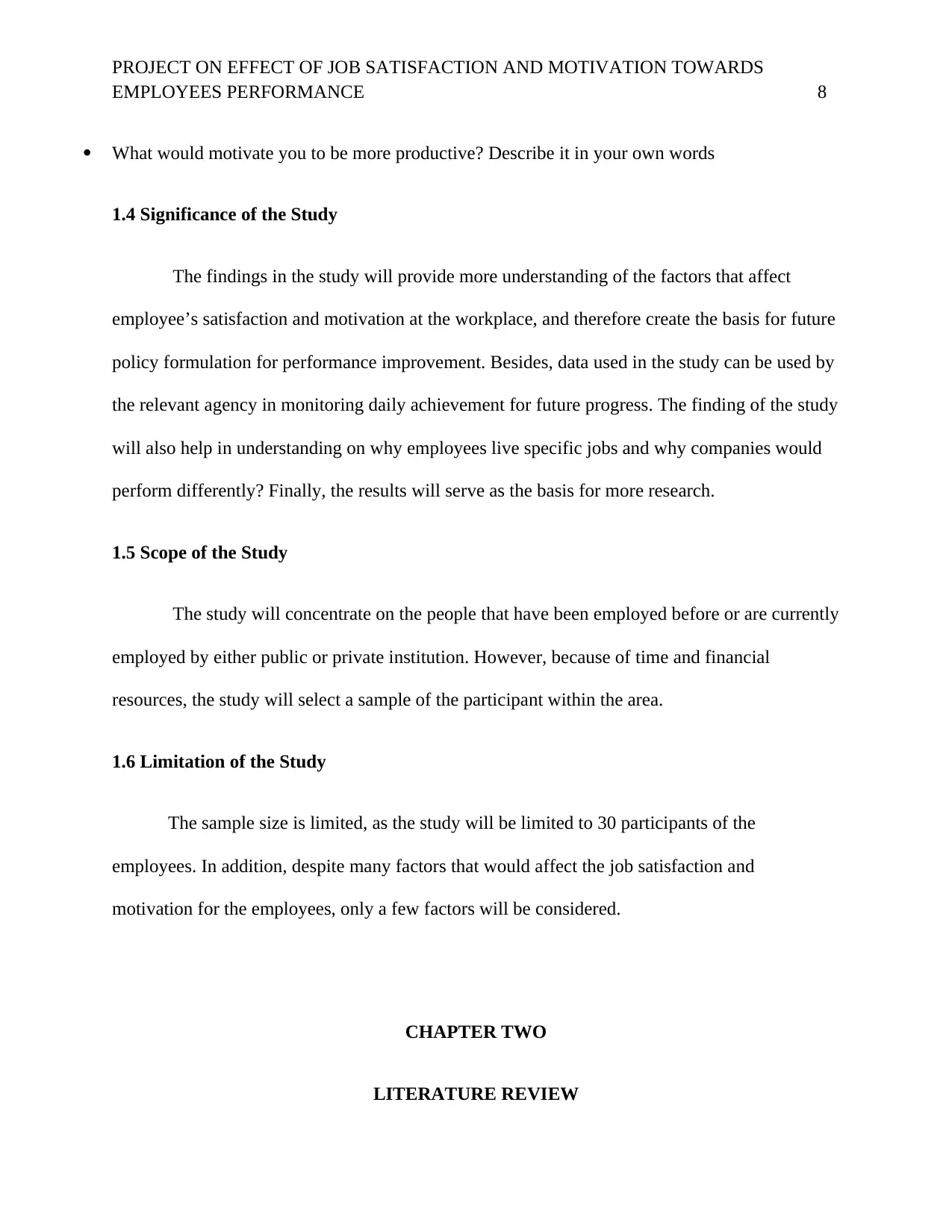
PROJECT ON EFFECT OF JOB SATISFACTION AND MOTIVATION TOWARDS
EMPLOYEES PERFORMANCE 8
What would motivate you to be more productive? Describe it in your own words
1.4 Significance of the Study
The findings in the study will provide more understanding of the factors that affect
employee’s satisfaction and motivation at the workplace, and therefore create the basis for future
policy formulation for performance improvement. Besides, data used in the study can be used by
the relevant agency in monitoring daily achievement for future progress. The finding of the study
will also help in understanding on why employees live specific jobs and why companies would
perform differently? Finally, the results will serve as the basis for more research.
1.5 Scope of the Study
The study will concentrate on the people that have been employed before or are currently
employed by either public or private institution. However, because of time and financial
resources, the study will select a sample of the participant within the area.
1.6 Limitation of the Study
The sample size is limited, as the study will be limited to 30 participants of the
employees. In addition, despite many factors that would affect the job satisfaction and
motivation for the employees, only a few factors will be considered.
CHAPTER TWO
LITERATURE REVIEW
EMPLOYEES PERFORMANCE 8
What would motivate you to be more productive? Describe it in your own words
1.4 Significance of the Study
The findings in the study will provide more understanding of the factors that affect
employee’s satisfaction and motivation at the workplace, and therefore create the basis for future
policy formulation for performance improvement. Besides, data used in the study can be used by
the relevant agency in monitoring daily achievement for future progress. The finding of the study
will also help in understanding on why employees live specific jobs and why companies would
perform differently? Finally, the results will serve as the basis for more research.
1.5 Scope of the Study
The study will concentrate on the people that have been employed before or are currently
employed by either public or private institution. However, because of time and financial
resources, the study will select a sample of the participant within the area.
1.6 Limitation of the Study
The sample size is limited, as the study will be limited to 30 participants of the
employees. In addition, despite many factors that would affect the job satisfaction and
motivation for the employees, only a few factors will be considered.
CHAPTER TWO
LITERATURE REVIEW
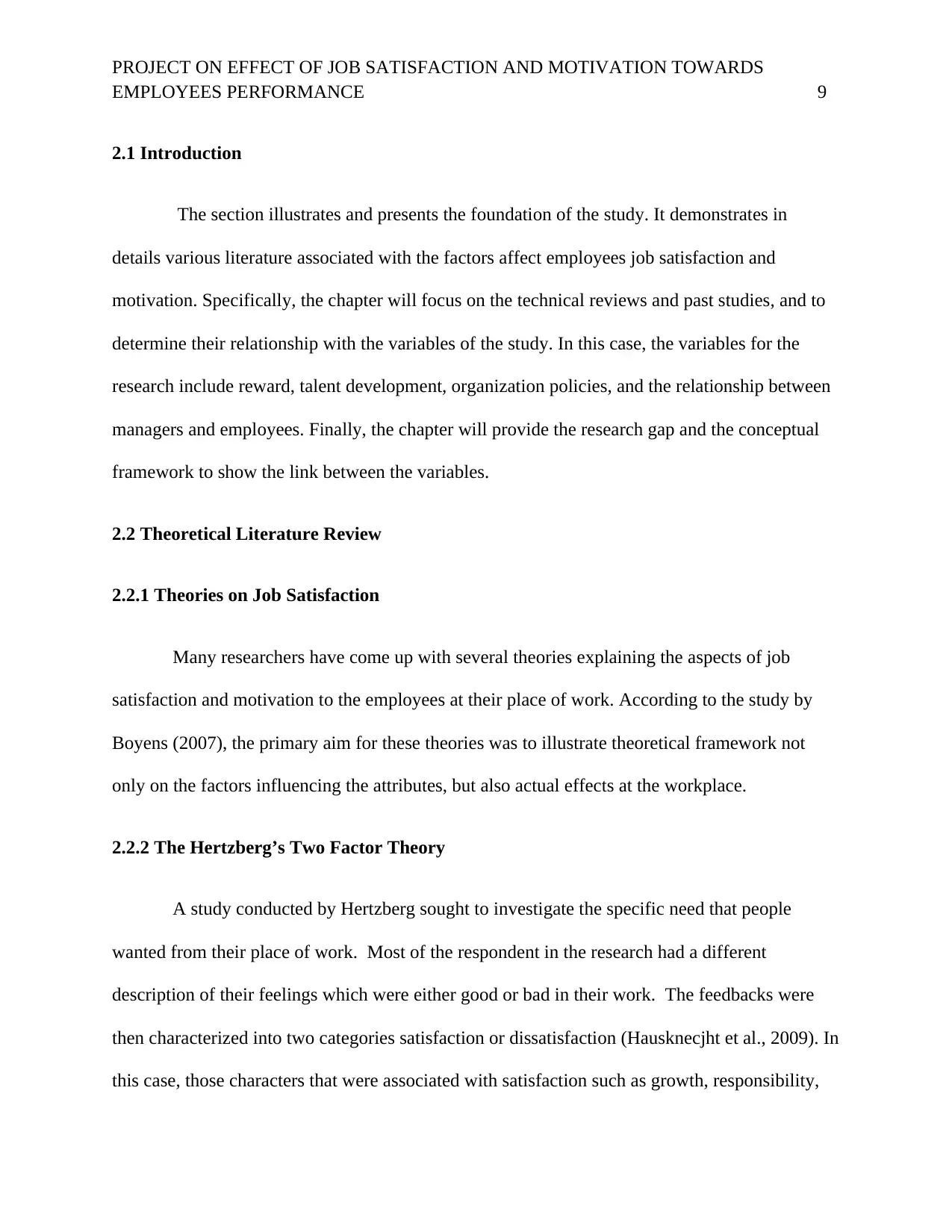
PROJECT ON EFFECT OF JOB SATISFACTION AND MOTIVATION TOWARDS
EMPLOYEES PERFORMANCE 9
2.1 Introduction
The section illustrates and presents the foundation of the study. It demonstrates in
details various literature associated with the factors affect employees job satisfaction and
motivation. Specifically, the chapter will focus on the technical reviews and past studies, and to
determine their relationship with the variables of the study. In this case, the variables for the
research include reward, talent development, organization policies, and the relationship between
managers and employees. Finally, the chapter will provide the research gap and the conceptual
framework to show the link between the variables.
2.2 Theoretical Literature Review
2.2.1 Theories on Job Satisfaction
Many researchers have come up with several theories explaining the aspects of job
satisfaction and motivation to the employees at their place of work. According to the study by
Boyens (2007), the primary aim for these theories was to illustrate theoretical framework not
only on the factors influencing the attributes, but also actual effects at the workplace.
2.2.2 The Hertzberg’s Two Factor Theory
A study conducted by Hertzberg sought to investigate the specific need that people
wanted from their place of work. Most of the respondent in the research had a different
description of their feelings which were either good or bad in their work. The feedbacks were
then characterized into two categories satisfaction or dissatisfaction (Hausknecjht et al., 2009). In
this case, those characters that were associated with satisfaction such as growth, responsibility,
EMPLOYEES PERFORMANCE 9
2.1 Introduction
The section illustrates and presents the foundation of the study. It demonstrates in
details various literature associated with the factors affect employees job satisfaction and
motivation. Specifically, the chapter will focus on the technical reviews and past studies, and to
determine their relationship with the variables of the study. In this case, the variables for the
research include reward, talent development, organization policies, and the relationship between
managers and employees. Finally, the chapter will provide the research gap and the conceptual
framework to show the link between the variables.
2.2 Theoretical Literature Review
2.2.1 Theories on Job Satisfaction
Many researchers have come up with several theories explaining the aspects of job
satisfaction and motivation to the employees at their place of work. According to the study by
Boyens (2007), the primary aim for these theories was to illustrate theoretical framework not
only on the factors influencing the attributes, but also actual effects at the workplace.
2.2.2 The Hertzberg’s Two Factor Theory
A study conducted by Hertzberg sought to investigate the specific need that people
wanted from their place of work. Most of the respondent in the research had a different
description of their feelings which were either good or bad in their work. The feedbacks were
then characterized into two categories satisfaction or dissatisfaction (Hausknecjht et al., 2009). In
this case, those characters that were associated with satisfaction such as growth, responsibility,
⊘ This is a preview!⊘
Do you want full access?
Subscribe today to unlock all pages.

Trusted by 1+ million students worldwide
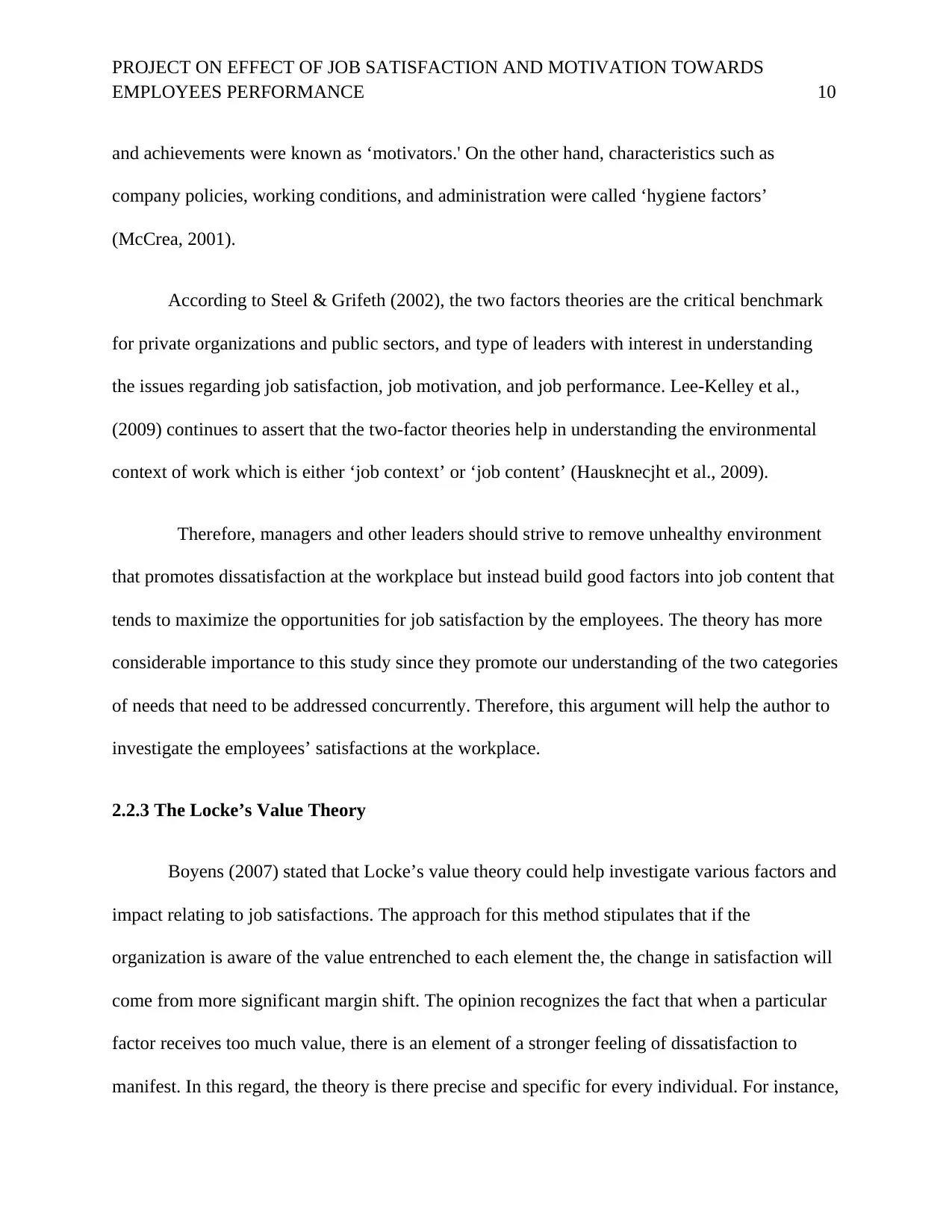
PROJECT ON EFFECT OF JOB SATISFACTION AND MOTIVATION TOWARDS
EMPLOYEES PERFORMANCE 10
and achievements were known as ‘motivators.' On the other hand, characteristics such as
company policies, working conditions, and administration were called ‘hygiene factors’
(McCrea, 2001).
According to Steel & Grifeth (2002), the two factors theories are the critical benchmark
for private organizations and public sectors, and type of leaders with interest in understanding
the issues regarding job satisfaction, job motivation, and job performance. Lee-Kelley et al.,
(2009) continues to assert that the two-factor theories help in understanding the environmental
context of work which is either ‘job context’ or ‘job content’ (Hausknecjht et al., 2009).
Therefore, managers and other leaders should strive to remove unhealthy environment
that promotes dissatisfaction at the workplace but instead build good factors into job content that
tends to maximize the opportunities for job satisfaction by the employees. The theory has more
considerable importance to this study since they promote our understanding of the two categories
of needs that need to be addressed concurrently. Therefore, this argument will help the author to
investigate the employees’ satisfactions at the workplace.
2.2.3 The Locke’s Value Theory
Boyens (2007) stated that Locke’s value theory could help investigate various factors and
impact relating to job satisfactions. The approach for this method stipulates that if the
organization is aware of the value entrenched to each element the, the change in satisfaction will
come from more significant margin shift. The opinion recognizes the fact that when a particular
factor receives too much value, there is an element of a stronger feeling of dissatisfaction to
manifest. In this regard, the theory is there precise and specific for every individual. For instance,
EMPLOYEES PERFORMANCE 10
and achievements were known as ‘motivators.' On the other hand, characteristics such as
company policies, working conditions, and administration were called ‘hygiene factors’
(McCrea, 2001).
According to Steel & Grifeth (2002), the two factors theories are the critical benchmark
for private organizations and public sectors, and type of leaders with interest in understanding
the issues regarding job satisfaction, job motivation, and job performance. Lee-Kelley et al.,
(2009) continues to assert that the two-factor theories help in understanding the environmental
context of work which is either ‘job context’ or ‘job content’ (Hausknecjht et al., 2009).
Therefore, managers and other leaders should strive to remove unhealthy environment
that promotes dissatisfaction at the workplace but instead build good factors into job content that
tends to maximize the opportunities for job satisfaction by the employees. The theory has more
considerable importance to this study since they promote our understanding of the two categories
of needs that need to be addressed concurrently. Therefore, this argument will help the author to
investigate the employees’ satisfactions at the workplace.
2.2.3 The Locke’s Value Theory
Boyens (2007) stated that Locke’s value theory could help investigate various factors and
impact relating to job satisfactions. The approach for this method stipulates that if the
organization is aware of the value entrenched to each element the, the change in satisfaction will
come from more significant margin shift. The opinion recognizes the fact that when a particular
factor receives too much value, there is an element of a stronger feeling of dissatisfaction to
manifest. In this regard, the theory is there precise and specific for every individual. For instance,
Paraphrase This Document
Need a fresh take? Get an instant paraphrase of this document with our AI Paraphraser
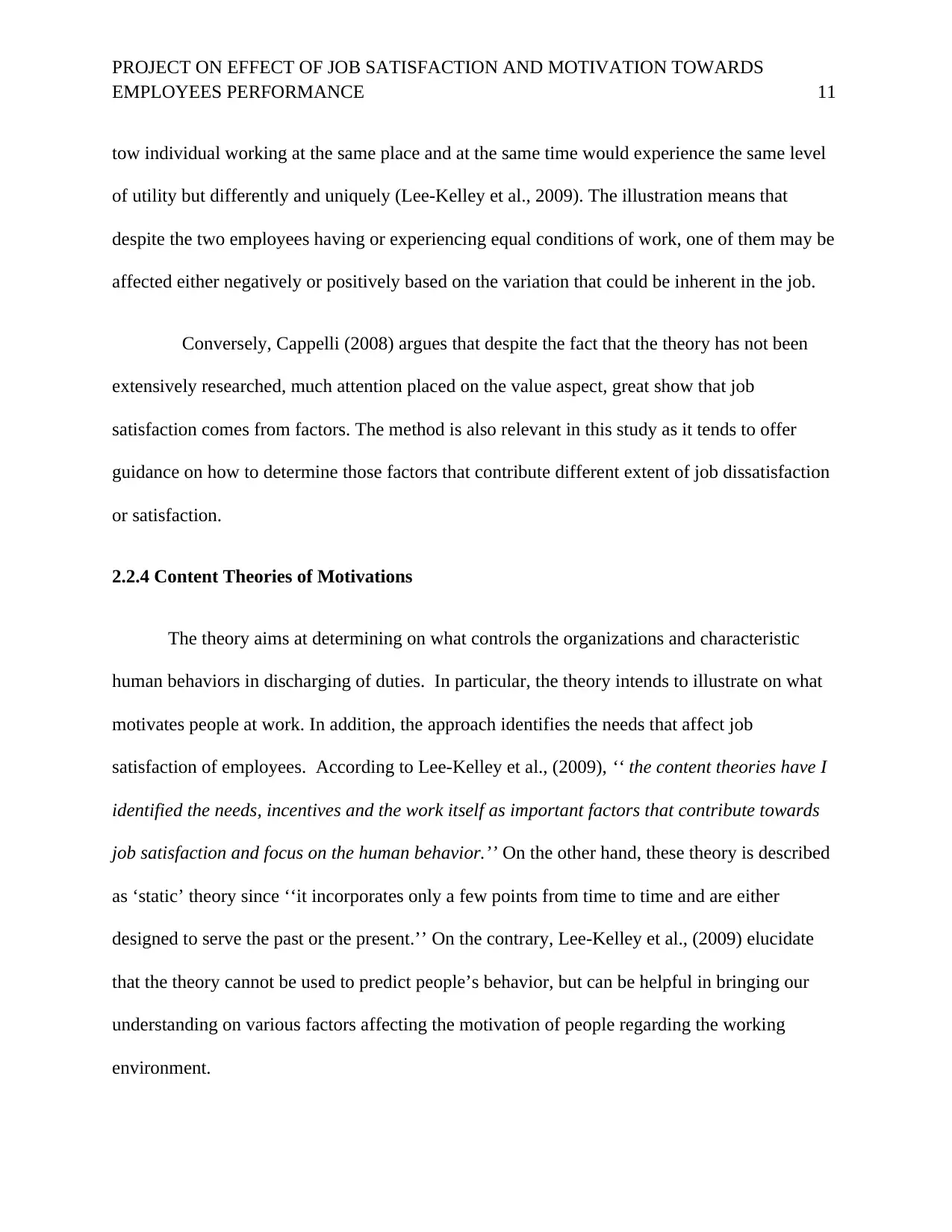
PROJECT ON EFFECT OF JOB SATISFACTION AND MOTIVATION TOWARDS
EMPLOYEES PERFORMANCE 11
tow individual working at the same place and at the same time would experience the same level
of utility but differently and uniquely (Lee-Kelley et al., 2009). The illustration means that
despite the two employees having or experiencing equal conditions of work, one of them may be
affected either negatively or positively based on the variation that could be inherent in the job.
Conversely, Cappelli (2008) argues that despite the fact that the theory has not been
extensively researched, much attention placed on the value aspect, great show that job
satisfaction comes from factors. The method is also relevant in this study as it tends to offer
guidance on how to determine those factors that contribute different extent of job dissatisfaction
or satisfaction.
2.2.4 Content Theories of Motivations
The theory aims at determining on what controls the organizations and characteristic
human behaviors in discharging of duties. In particular, the theory intends to illustrate on what
motivates people at work. In addition, the approach identifies the needs that affect job
satisfaction of employees. According to Lee-Kelley et al., (2009), ‘‘ the content theories have I
identified the needs, incentives and the work itself as important factors that contribute towards
job satisfaction and focus on the human behavior.’’ On the other hand, these theory is described
as ‘static’ theory since ‘‘it incorporates only a few points from time to time and are either
designed to serve the past or the present.’’ On the contrary, Lee-Kelley et al., (2009) elucidate
that the theory cannot be used to predict people’s behavior, but can be helpful in bringing our
understanding on various factors affecting the motivation of people regarding the working
environment.
EMPLOYEES PERFORMANCE 11
tow individual working at the same place and at the same time would experience the same level
of utility but differently and uniquely (Lee-Kelley et al., 2009). The illustration means that
despite the two employees having or experiencing equal conditions of work, one of them may be
affected either negatively or positively based on the variation that could be inherent in the job.
Conversely, Cappelli (2008) argues that despite the fact that the theory has not been
extensively researched, much attention placed on the value aspect, great show that job
satisfaction comes from factors. The method is also relevant in this study as it tends to offer
guidance on how to determine those factors that contribute different extent of job dissatisfaction
or satisfaction.
2.2.4 Content Theories of Motivations
The theory aims at determining on what controls the organizations and characteristic
human behaviors in discharging of duties. In particular, the theory intends to illustrate on what
motivates people at work. In addition, the approach identifies the needs that affect job
satisfaction of employees. According to Lee-Kelley et al., (2009), ‘‘ the content theories have I
identified the needs, incentives and the work itself as important factors that contribute towards
job satisfaction and focus on the human behavior.’’ On the other hand, these theory is described
as ‘static’ theory since ‘‘it incorporates only a few points from time to time and are either
designed to serve the past or the present.’’ On the contrary, Lee-Kelley et al., (2009) elucidate
that the theory cannot be used to predict people’s behavior, but can be helpful in bringing our
understanding on various factors affecting the motivation of people regarding the working
environment.
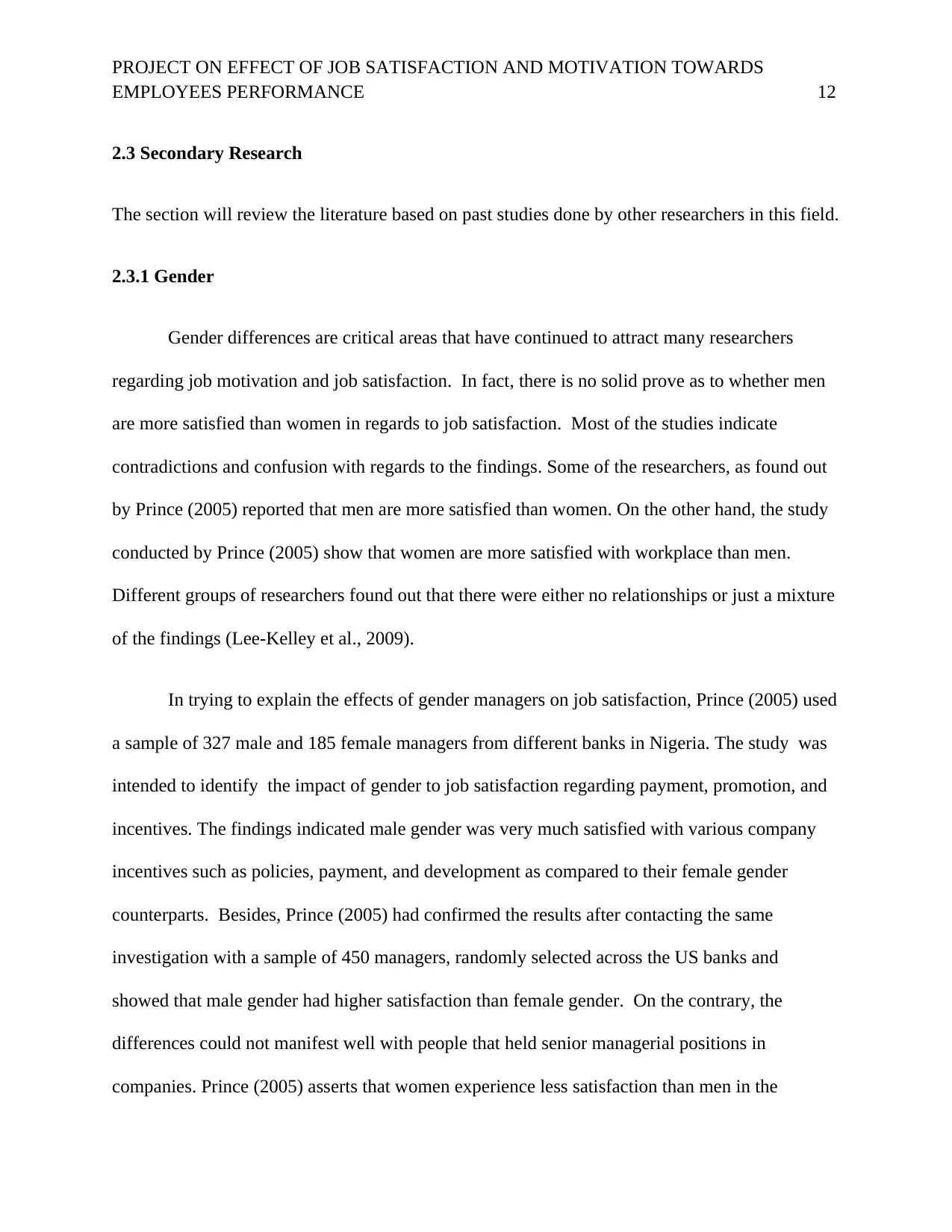
PROJECT ON EFFECT OF JOB SATISFACTION AND MOTIVATION TOWARDS
EMPLOYEES PERFORMANCE 12
2.3 Secondary Research
The section will review the literature based on past studies done by other researchers in this field.
2.3.1 Gender
Gender differences are critical areas that have continued to attract many researchers
regarding job motivation and job satisfaction. In fact, there is no solid prove as to whether men
are more satisfied than women in regards to job satisfaction. Most of the studies indicate
contradictions and confusion with regards to the findings. Some of the researchers, as found out
by Prince (2005) reported that men are more satisfied than women. On the other hand, the study
conducted by Prince (2005) show that women are more satisfied with workplace than men.
Different groups of researchers found out that there were either no relationships or just a mixture
of the findings (Lee-Kelley et al., 2009).
In trying to explain the effects of gender managers on job satisfaction, Prince (2005) used
a sample of 327 male and 185 female managers from different banks in Nigeria. The study was
intended to identify the impact of gender to job satisfaction regarding payment, promotion, and
incentives. The findings indicated male gender was very much satisfied with various company
incentives such as policies, payment, and development as compared to their female gender
counterparts. Besides, Prince (2005) had confirmed the results after contacting the same
investigation with a sample of 450 managers, randomly selected across the US banks and
showed that male gender had higher satisfaction than female gender. On the contrary, the
differences could not manifest well with people that held senior managerial positions in
companies. Prince (2005) asserts that women experience less satisfaction than men in the
EMPLOYEES PERFORMANCE 12
2.3 Secondary Research
The section will review the literature based on past studies done by other researchers in this field.
2.3.1 Gender
Gender differences are critical areas that have continued to attract many researchers
regarding job motivation and job satisfaction. In fact, there is no solid prove as to whether men
are more satisfied than women in regards to job satisfaction. Most of the studies indicate
contradictions and confusion with regards to the findings. Some of the researchers, as found out
by Prince (2005) reported that men are more satisfied than women. On the other hand, the study
conducted by Prince (2005) show that women are more satisfied with workplace than men.
Different groups of researchers found out that there were either no relationships or just a mixture
of the findings (Lee-Kelley et al., 2009).
In trying to explain the effects of gender managers on job satisfaction, Prince (2005) used
a sample of 327 male and 185 female managers from different banks in Nigeria. The study was
intended to identify the impact of gender to job satisfaction regarding payment, promotion, and
incentives. The findings indicated male gender was very much satisfied with various company
incentives such as policies, payment, and development as compared to their female gender
counterparts. Besides, Prince (2005) had confirmed the results after contacting the same
investigation with a sample of 450 managers, randomly selected across the US banks and
showed that male gender had higher satisfaction than female gender. On the contrary, the
differences could not manifest well with people that held senior managerial positions in
companies. Prince (2005) asserts that women experience less satisfaction than men in the
⊘ This is a preview!⊘
Do you want full access?
Subscribe today to unlock all pages.

Trusted by 1+ million students worldwide
1 out of 37
Related Documents
Your All-in-One AI-Powered Toolkit for Academic Success.
+13062052269
info@desklib.com
Available 24*7 on WhatsApp / Email
![[object Object]](/_next/static/media/star-bottom.7253800d.svg)
Unlock your academic potential
Copyright © 2020–2025 A2Z Services. All Rights Reserved. Developed and managed by ZUCOL.





